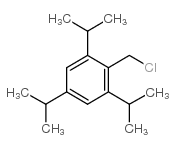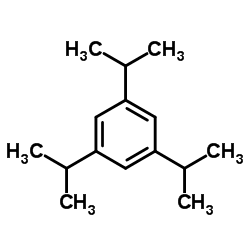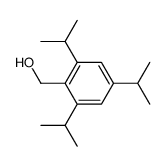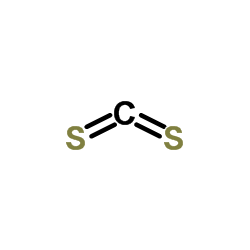38580-86-8
| 中文名 | 2,4,6-三异丙基苄氯 |
|---|---|
| 英文名 | 2,4,6-Triisopropylbenzyl Chloride |
| 中文别名 | 2,4,6-三异丙基氯苄 |
| 英文别名 |
2-(chloromethyl)-1,3,5-tri(propan-2-yl)benzene
2-Chloromethyl-1,3,5-triisopropylbenzene |
| 密度 | 0.945g/cm3 |
|---|---|
| 沸点 | 289.4ºC at 760 mmHg |
| 熔点 | 36ºC |
| 分子式 | C16H25Cl |
| 分子量 | 252.82300 |
| 闪点 | 125ºC |
| 精确质量 | 252.16400 |
| LogP | 5.79560 |
| 折射率 | 1.499 |
| 储存条件 | 密封、阴凉、干燥保存 |
| 稳定性 | 常规情况下不会分解,没有危险反应 |
| 计算化学 | 1.疏水参数计算参考值(XlogP):5.7 2.氢键供体数量:0 3.氢键受体数量:0 4.可旋转化学键数量:4 5.互变异构体数量:无 6.拓扑分子极性表面积0 7.重原子数量:17 8.表面电荷:0 9.复杂度:202 10.同位素原子数量:0 11.确定原子立构中心数量:0 12.不确定原子立构中心数量:0 13.确定化学键立构中心数量:0 14.不确定化学键立构中心数量:0 15.共价键单元数量:1 |
| 更多 | 1. 性状:未确定 2. 密度(g/mL,20 ºC):未确定 3. 相对蒸汽密度(g/mL,空气=1): 未确定 4. 熔点(ºC):36 5. 沸点(ºC,1.1 kPa):未确定 6. 沸点(ºC,5mm hg):未确定 7. 折射率:未确定 8. 闪点(ºC):未确定 9. 比旋光度(º):未确定 10. 自燃点或引燃温度(ºC): 未确定 11. 蒸气压(kPa,25ºC):未确定 12. 饱和蒸气压(kPa,60ºC): 未确定 13. 燃烧热(KJ/mol):未确定 14. 临界温度(ºC):未确定 15. 临界压力(KPa):未确定 16. 油水(辛醇/水)分配系数的对数值:未确定 17. 爆炸上限(%,V/V):未确定 18. 爆炸下限(%,V/V):未确定 19. 溶解性:未确定 |
|
2,4,6-Triisopropylbenzyl Chloride
Revision number: 5
SAFETY DATA SHEET Section1. IDENTIFICATION Product name:2,4,6-Triisopropylbenzyl Chloride Revision number:5 Section2. HAZARDS IDENTIFICATION GHS classification PHYSICAL HAZARDS Category 1 Corrosive to metals HEALTH HAZARDS Category 1C Skin corrosion/irritation Serious eye damage/eye irritationCategory 1 Not classified ENVIRONMENTAL HAZARDS GHS label elements, including precautionary statements Pictograms or hazard symbols Signal wordDanger Hazard statementsMay be corrosive to metals Causes severe skin burns and eye damage Precautionary statements: [Prevention]Keep only in original container. Do not breathe dust/fume/gas/mist/vapours/spray. Wash hands thoroughly after handling. Wear protective gloves/eye protection/face protection. [Response]IF INHALED: Remove victim to fresh air and keep at rest in a position comfortable for breathing. IF SWALLOWED: Rinse mouth. Do NOT induce vomiting. IF IN EYES: Rinse cautiously with water for several minutes. Remove contact lenses, if present and easy to do. Continue rinsing. IF ON SKIN (or hair): Remove/Take off immediately all contaminated clothing. Rinse skin with water/shower. Wash contaminated clothing before reuse. Immediately call a POISON CENTER or doctor/physician. Absorb spillage to prevent material damage. [Storage]Store locked up. [Disposal]Dispose of contents/container through a waste management company authorized by the local government. 2,4,6-Triisopropylbenzyl Chloride Section3. COMPOSITION/INFORMATION ON INGREDIENTS Substance/mixture:Substance Components:2,4,6-Triisopropylbenzyl Chloride Percent:>98.0%(GC) CAS Number:38580-86-8 Synonyms:2-Chloromethyl-1,3,5-triisopropylbenzene Chemical Formula:C16H25Cl Section4. FIRST AID MEASURES Remove victim to fresh air and keep at rest in a position comfortable for breathing. Inhalation: Immediately call a POISON CENTER or doctor/physician. Skin contact:Remove/Take off immediately all contaminated clothing. Gently wash with plenty of soap and water. Immediately call a POISON CENTER or doctor/physician. Eye contact:Rinse cautiously with water for several minutes. Remove contact lenses, if present and easy to do. Continue rinsing.Immediately call a POISON CENTER or doctor/physician. Ingestion:Immediately call a POISON CENTER or doctor/physician. Rinse mouth. Do NOT induce vomiting. A rescuer should wear personal protective equipment, such as rubber gloves and air- Protection of first-aiders: tight goggles. Section5. FIRE-FIGHTING MEASURES Suitable extinguishingDry chemical, foam, water spray, carbon dioxide. media: Specific hazards arising Take care as it may decompose upon combustion or in high temperatures to from the chemical:generate poisonous fume. Precautions for firefighters: Fire-extinguishing work is done from the windward and the suitable fire-extinguishing method according to the surrounding situation is used. Uninvolved persons should evacuate to a safe place. In case of fire in the surroundings: Remove movable containers if safe to do so. Special protectiveWhen extinguishing fire, be sure to wear personal protective equipment. equipment for firefighters: Section6. ACCIDENTAL RELEASE MEASURES Personal precautions,Use extra personal protective equipment (P3 filter respirator for toxic particles). Keep protective equipment and people away from and upwind of spill/leak. Entry to non-involved personnel should emergency procedures: be controlled around the leakage area by roping off, etc. Environmental precautions: Prevent product from entering drains. Methods and materials for Sweep dust to collect it into an airtight container, taking care not to disperse it. containment and cleaning Adhered or collected material should be promptly disposed of, in accordance with up: appropriate laws and regulations. Section7. HANDLING AND STORAGE Precautions for safe handling Technical measures:Handling is performed in a well ventilated place. Wear suitable protective equipment. Prevent dispersion of dust. Wash hands and face thoroughly after handling. Use a closed system if possible. Use a local exhaust if dust or aerosol will be generated. Advice on safe handling:Avoid contact with skin, eyes and clothing. May develop pressure. Open carefully. Use corrosive resistant equipment. Conditions for safe storage, including any incompatibilities Storage conditions:Keep container tightly closed. Store in a refrigerator. Store locked up. Store away from incompatible materials such as oxidizing agents. Comply with laws. Keep only in original container. Packaging material: 2,4,6-Triisopropylbenzyl Chloride Section8. EXPOSURE CONTROLS / PERSONAL PROTECTION Engineering controls:Install a closed system or local exhaust. Also install safety shower and eye bath. Personal protective equipment Respiratory protection: Dust respirator, self-contained breathing apparatus(SCBA), supplied air respirator, etc. Use respirators approved under appropriate government standards and follow local and national regulations. Hand protection:Impervious gloves. Safety goggles. A face-shield, if the situation requires. Eye protection: Skin and body protection: Impervious protective clothing. Protective boots, if the situation requires. Section9. PHYSICAL AND CHEMICAL PROPERTIES Physical state (20°C):Solid Crystal- Powder Form: Colour:White - Very pale yellow No data available Odour: pH: No data available Melting point/freezing point:36°C Boiling point/range:No data available Flash point:No data available Flammability or explosive limits: Lower:No data available Upper:No data available Relative density:No data available Solubility(ies): [Water]No data available [Other solvents]No data available Section10. STABILITY AND REACTIVITY Chemical stability:Stable under proper conditions. Possibility of hazardous No special reactivity has been reported. reactions: Incompatible materials: Oxidizing agents Hazardous decomposition Carbon monoxide, Carbon dioxide, Hydrogen chloride products: Section11. TOXICOLOGICAL INFORMATION Acute Toxicity:No data available Skin corrosion/irritation: No data available Serious eyeNo data available damage/irritation: Germ cell mutagenicity: No data available Carcinogenicity: No data available IARC = NTP =No data available Reproductive toxicity:No data available Section12. ECOLOGICAL INFORMATION Ecotoxicity: Fish:No data available Crustacea:No data available Algae:No data available Persistence / degradability: No data available BioaccumulativeNo data available potential(BCF): Mobility in soil 2,4,6-Triisopropylbenzyl Chloride Section12. ECOLOGICAL INFORMATION Log Pow:No data available Soil adsorption (Koc): No data available Henry's LawNo data available constant(PaM3/mol): Section13. DISPOSAL CONSIDERATIONS Recycle to process, if possible. Consult your local regional authorities. You may be able to dissolve or mix material with a combustible solvent and burn in a chemical incinerator equipped with an afterburner and scrubber system. Observe all federal, state and local regulations when disposing of the substance. Section14. TRANSPORT INFORMATION Hazards Class:8: Corrosive. UN-No:3261 Proper shipping name:Corrosive solid, acidic, organic, n.o.s. Packing group:III Section15. REGULATORY INFORMATION Safe management ordinance of dangerous chemical product (State Council announces on January 26, 2002 and revised on February 16,2011): Safe use and production, the storage of a dangerous chemical, transport, loading and unloading were prescribed. SECTION 16 - ADDITIONAL INFORMATION N/A |
|
生态学数据: 对水是稍微有危害的不要让未稀释或大量的产品接触地下水、水道或者污水系统,若无政府许可,勿将材料排入周围环境。
|
| 风险声明 (欧洲) | R34 |
|---|---|
| 安全声明 (欧洲) | S36/S37/S39 |
| 危险品运输编码 | UN 3261 |
| 海关编码 | 2903999090 |
|
~% 
38580-86-8 |
| 文献:Nilsson,A.; Olsson,K. Acta Chemica Scandinavica, Series B: Organic Chemistry and Biochemistry, 1975 , vol. 29, p. 752 - 756 |
|
~% 
38580-86-8 |
| 文献:Wagner, Peter J.; Meador, Michael A.; Zhou, Boli; Park, Bong-Ser Journal of the American Chemical Society, 1991 , vol. 113, # 25 p. 9630 - 9639 |
|
~% 
38580-86-8 |
| 文献:Wagner, Peter J.; Meador, Michael A.; Zhou, Boli; Park, Bong-Ser Journal of the American Chemical Society, 1991 , vol. 113, # 25 p. 9630 - 9639 |
|
~% 
38580-86-8 |
| 文献:Wagner, Peter J.; Meador, Michael A.; Zhou, Boli; Park, Bong-Ser Journal of the American Chemical Society, 1991 , vol. 113, # 25 p. 9630 - 9639 |
|
~% 
38580-86-8 |
| 文献:Chandrasekhar, Vadapalli; Sasikumar, Palani; Senapati, Tapas; Dey, Atanu Inorganica Chimica Acta, 2010 , vol. 363, # 12 p. 2920 - 2928 |
|
~%
详细
|
| 文献:Fuson et al. Journal of the American Chemical Society, 1942 , vol. 64, p. 30,31 Org. Synth. Coll., 1955 , vol. Vol. III, p. 549,551 |
| 海关编码 | 2903999090 |
|---|---|
| 中文概述 | 2903999090 其他芳烃卤化衍生物. 增值税率:17.0% 退税率:9.0% 监管条件:无 最惠国关税:5.5% 普通关税:30.0% |
| 申报要素 | 品名, 成分含量, 用途 |
| Summary | 2903999090 halogenated derivatives of aromatic hydrocarbons VAT:17.0% Tax rebate rate:9.0% Supervision conditions:none MFN tariff:5.5% General tariff:30.0% |










